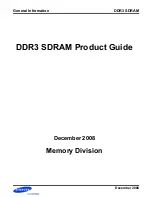
63
AT94KAL Series FPSLIC
Rev. 1138G–FPSLI–11/03
The MCU after five CPU clock-cycles, and can be used when an external clock signal is
applied to the XTAL1 pin. This setting does not use the WDT oscillator, and enables very fast
start-up from the Sleep, Power-down or Power-save modes if the clock signal is present dur-
ing sleep.
RESET can be connected to V
CC
directly or via an external pull-up resistor. By holding the pin
Low for a period after V
CC
has been applied, the Power-on Reset period can be extended.
Refer to Figure 38 for a timing example on this.
Figure 38.
MCU Start-up, RESET Controlled Externally
External Reset
An external reset is generated by a low-level on the AVRRESET pin. When the applied signal
reaches the Reset Threshold Voltage – V
RST
– on its positive edge, the delay timer starts the
MCU after the Time-out period t
TOUT
has expired.
Watchdog Reset
When the Watchdog times out, it will generate a short reset pulse of 1 XTAL cycle duration.
On the falling edge of this pulse, the delay timer starts counting the Time-out period t
TOUT
.
Time-out period t
TOUT
is approximately 3 µs – at V
CC
= 3.3V. the period of the time out is volt-
age dependent.
Software Reset
See “Software Control of System Configuration” on page 51.
Interrupt Handling
The embedded AVR core has one dedicated 8-bit Interrupt Mask control register: TIMSK –
Timer/Counter Interrupt Mask Register. In addition, other enable and mask bits can be found
in the peripheral control registers.
When an interrupt occurs, the Global Interrupt Enable I-bit is cleared (zero) and all interrupts
are disabled. The user software can set (one) the I-bit to enable nested interrupts. The I-bit is
set (one) when a Return from Interrupt instruction (RETI) is executed.
When the Program Counter is vectored to the actual interrupt vector in order to execute the
interrupt handling routine, the hardware clears the corresponding flag that generated the inter-
rupt. Some of the interrupt flags can also be cleared by writing a logic 1 to the flag bit
position(s) to be cleared.
If an interrupt condition occurs when the corresponding interrupt enable bit is cleared (zero),
the interrupt flag will be set and remembered until the interrupt is enabled, or the flag is
cleared by software.
If one or more interrupt conditions occur when the global interrupt enable bit is cleared (zero),
the corresponding interrupt flag(s) will be set and remembered until the global interrupt enable
bit is set (one), and will be executed by order of priority.
The status register is not automatically stored when entering an interrupt routine and restored
when returning from an interrupt routine. This must be handled by software.
RESET
TIME-OUT
INTERNAL RESET
t
TOUT
V
RST
V
CC
V
POT
















































